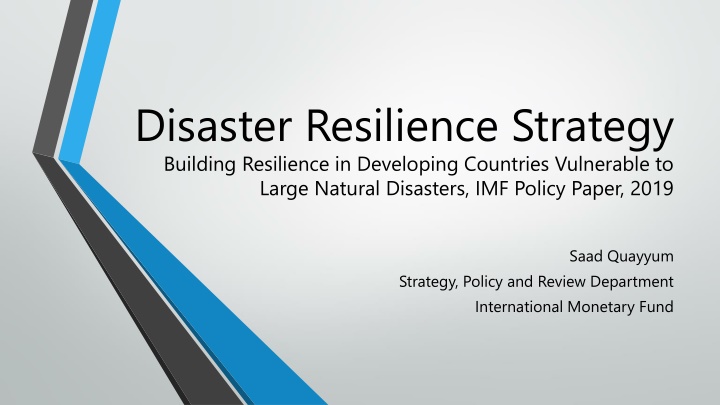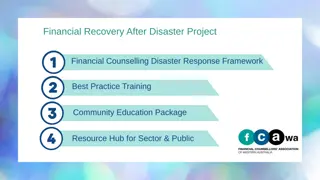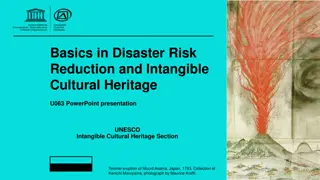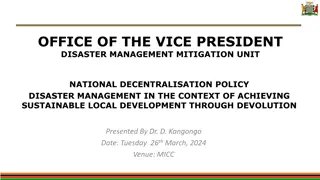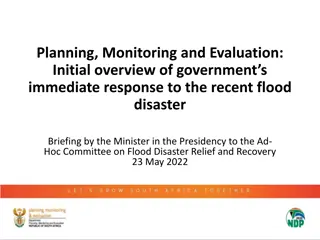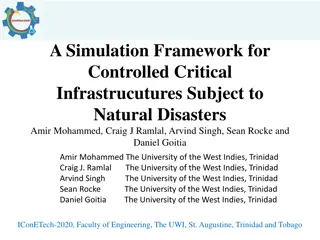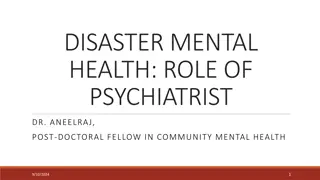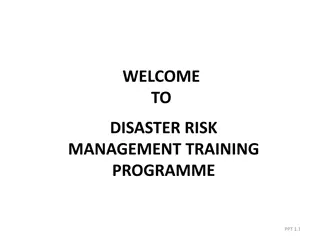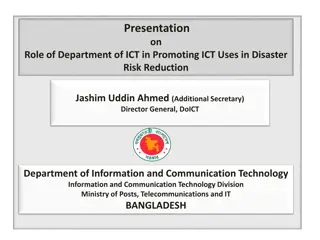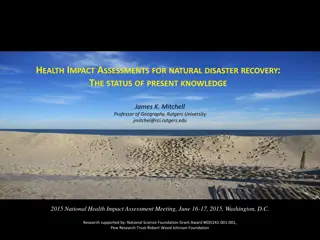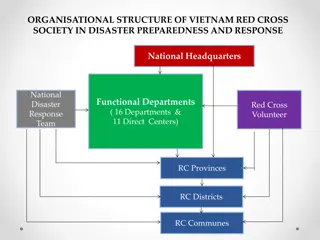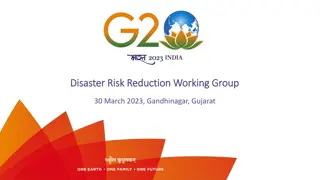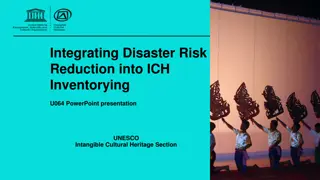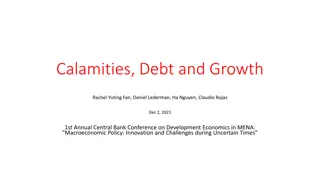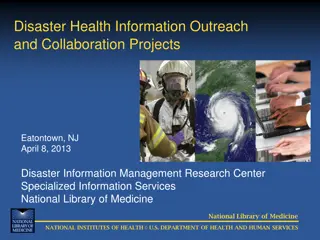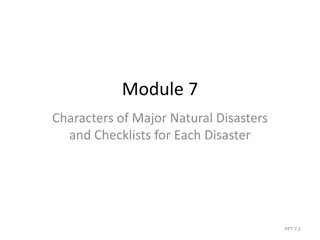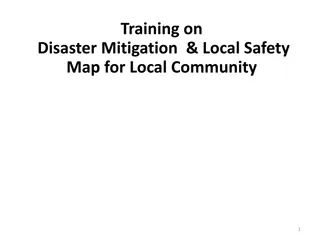Disaster Resilience Strategy in Developing Countries Vulnerable to Natural Disasters
The IMF's policy paper highlights key challenges faced by small states in building resilience, such as under-investment and donor support post-disaster rather than pre-disaster. The Disaster Resilience Strategy (DRS) emphasizes three pillars for intervention: post-disaster resilience, financial resilience, and structural resilience. Structural resilience, in particular, shows significant returns on investing in resilient infrastructure, despite initial higher costs. The DRS recommends a forward-looking diagnostic approach, risk assessment, and investment prioritization for effective implementation. Financial resilience strategies include a risk-layered approach and mechanisms like disaster funds and contingent loans to manage disaster risks effectively.
Download Presentation

Please find below an Image/Link to download the presentation.
The content on the website is provided AS IS for your information and personal use only. It may not be sold, licensed, or shared on other websites without obtaining consent from the author.If you encounter any issues during the download, it is possible that the publisher has removed the file from their server.
You are allowed to download the files provided on this website for personal or commercial use, subject to the condition that they are used lawfully. All files are the property of their respective owners.
The content on the website is provided AS IS for your information and personal use only. It may not be sold, licensed, or shared on other websites without obtaining consent from the author.
E N D
Presentation Transcript
Disaster Resilience Strategy Building Resilience in Developing Countries Vulnerable to Large Natural Disasters, IMF Policy Paper, 2019 Saad Quayyum Strategy, Policy and Review Department International Monetary Fund
Key Challenges in Small States Under-investment in resilience - Limited domestic resources - Donor support focused more towards post-disaster recovery compared to building ex-ante resilience - Weak capacity Limited fiscal space to deal with large recovery costs, low insurance coverage, dependence on donors for post-disaster recovery Resilience plans not well-developed (or missing); capacity constraints Fragmented donor support
Disaster Resilience Strategy (DRS) Three Complementary Pillars for Ex-Ante Intervention PILLAR III PILLAR II PILLAR I Post-Disaster resilience Financial resilience Structural resilience - Effective systems for emergency response, reconstruction and smooth recovery after a disaster - Macro-Fiscal/reserve buffers, incl. dedicated saving funds - Contingency loans - Insurance - State contingent debt instruments - Resilient infrastructure - Appropriate building codes - Proper land use/zoning rules - Early waring systems
Pillar I: Structural Resilience Significant returns to investing in ex-ante structural resilience Resilient infrastructure 10- 30% more costly than non- resilient options But lower rebuilding/recovery costs & output loss over the long term
Pillar I: Structural Resilience DRS based on comprehensive forward-looking diagnostic. Risk assessment Project identification, costing and prioritization Investment scale-up needs to be accompanied by: Strong public financial management Medium term-fiscal and budgeting framework Robust public asset and investment management Sound regulations (building codes, zoning rules, land use) are important
Pillar II: Financial Resilience Risk-layered approach to disaster risk management: (different instruments for different disaster frequency and cost) Strong macro-fiscal management and buffers Self-insurance: disaster funds and contingency budgets Disaster Funds: Jamaica; Tuvalu Contingent loans: World Bank CAT-DDO (soft trigger): Dominican Rep., Seychelles, Sri Lanka IDB Contingent Credit Facilities (parametric triggers) AsDB Pacific Disaster Resilience Program: Tonga Traditional insurance: Regional insurance pools with parametric triggers (CCRIF, PCRIC, Africa Risk Capacity) Source: World Bank Catastrophe (CAT) bonds: Similar to insurance, but risk transferred to capital markets Limited sovereign uptake; CCRIF issued cat bond to reinsure State-contingent debt instruments (SCDI): Hurricane clauses (Grenada, Barbados debt restructuring)
Pillar III: Post-Disaster Resilience Detailed action plan to guide the post-disaster response of government agencies Clarify institutional arrangements & responsibilities Plans for quick resumptions of public services Social protection mechanism to extend support to the vulnerable Strong PFM/procurement system to aid recovery 7
Other Key Features of DRS Country Ownership Sound Financing Plan Domestic Revenue Mobilization Debt Donor support Consistency with multi-year macro-fiscal framework How will the plan impact growth, debt, current account ? Will debt remain sustainable?
Small States need significant support from other stakeholders World Bank (and other development banks): diagnostics, disaster risk reduction & financial resilience strategies, technical assistance for post-disaster resilience IMF: TA in macro-fiscal areas, making investment needs consistent within a sustainable macroeconomic framework in medium and long term Bilateral donors: support technical assistance, subsidize insurance, provide concessional financing Climate funds: unlock funding (simplify access) Official sector insurance companies: help design financial resilience strategy
Two DRS Pilots Completed Grenada Dominica Relatively lower exposure to hurricanes Slow moving disasters (sea level rise) a major concern IMF/WB Climate Change Policy Assessment Recent track record of fiscal responsibility Major World Bank and Green Climate Fund operations Significant exposure to natural disasters Category 5 hurricanes in 2015 and 2017 Fiscal sustainability challenges Country elaborated climate resilience and recovery plan Unique role of CREAD
Conclusion DRS based on a three-pillar strategy to improve structural, financial and post- disaster resilience Critical: DRS are home-grown Based on sound diagnostics, credible financing plan and sustainable multi-year macro-fiscal framework Implementation must be supported by multiple, coordinated stakeholders (TA & Financing) It should help to mobilize more resources towards building ex-ante resilience!
